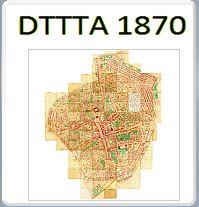Web publication of DTTTA - Debrecen

This is an ErdaGis system made for the database of the DTTTA (GSSHDCD) - Reconstruction of the Geo-social Structure of Debrecen City in 1870-72 project.
Project duration: 01-05-2010 - 30-06-2013
Lead researcher: Dr. János Mazsu, University of Debrecen (Debreceni Egyetem)
Joined the research: Dr. István Orosz and Péter Forisek University of Debrecen (Debreceni Egyetem)
External expert members of the program:
József Papp Microfilm library of DMJV; György Csáki and Norbert Vásárhelyi Erda Ltd.
The object of the programme: the improvement of the Digital History Database of the City of Debrecen (DHDCD in four phases:
• integrating the non-personal data (land register ranking, home size, home structure, home quality, ownership data, business use of residential buildings, auxiliary outbuildings, habitation-household connections, etc.) of the census into the database (DHDCD2),
• digitizing (that is, integrating into a geoinformatic framework) the map information of the City of Debrecen in the year 1872, compiled in the course of the systematisation and analysis of the whole map information of the archives of Debrecen, therefore, creating the Geoinformatic History Database of the City of Debrecen (GIHDCD),
• providing a possibility for communication and uniform queries between the DHDCD2 and the Geoinformatic History Database of the City of Debrecen,
• developing a uniform query system, thus creating an organically manageable geoinformatic and social history database for the purpose of social history research.
The result of the programme will be the formation of a uniform database, called the Geoinformatic and Social Structure History Database of the City of Debrecen (GSSHDCD), furthermore, laying down the exact mathematical foundations of the evaluation of the contents of the data, as well as expanding the scope of social historical analysis to simultaneous geoinformatic structure analysis.
The future Geoinformatic and Social Structure History Database of the City of Debrecen (GSSHDCD) will facilitate the overall and complex historical reconstruction, and simultaneous macro- and micro-historical analysis of the society of a city of 50 000 inhabitants, furthermore, it will ensure the simultaneous social historical and settlement morphological examination of the city broken down to individual and family-household-home units.
If you would like to enter the system, you can request a right to enter in the contact menu.
The system is available at an external window: ![]()
